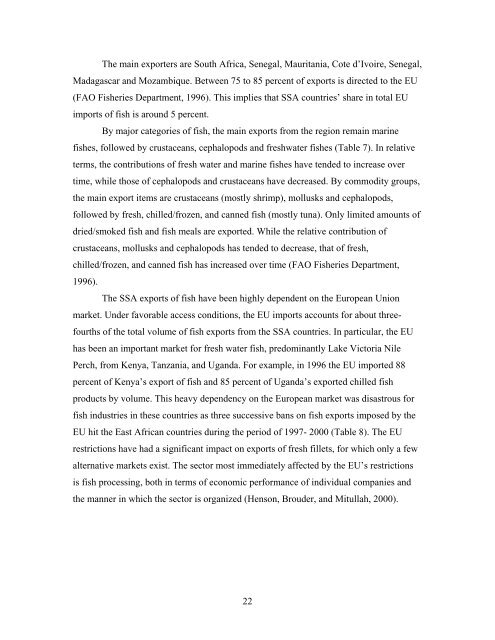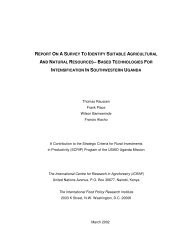Market Opportunities for African Agriculture - International Food ...
Market Opportunities for African Agriculture - International Food ...
Market Opportunities for African Agriculture - International Food ...
Create successful ePaper yourself
Turn your PDF publications into a flip-book with our unique Google optimized e-Paper software.
The main exporters are South Africa, Senegal, Mauritania, Cote d’Ivoire, Senegal,<br />
Madagascar and Mozambique. Between 75 to 85 percent of exports is directed to the EU<br />
(FAO Fisheries Department, 1996). This implies that SSA countries’ share in total EU<br />
imports of fish is around 5 percent.<br />
By major categories of fish, the main exports from the region remain marine<br />
fishes, followed by crustaceans, cephalopods and freshwater fishes (Table 7). In relative<br />
terms, the contributions of fresh water and marine fishes have tended to increase over<br />
time, while those of cephalopods and crustaceans have decreased. By commodity groups,<br />
the main export items are crustaceans (mostly shrimp), mollusks and cephalopods,<br />
followed by fresh, chilled/frozen, and canned fish (mostly tuna). Only limited amounts of<br />
dried/smoked fish and fish meals are exported. While the relative contribution of<br />
crustaceans, mollusks and cephalopods has tended to decrease, that of fresh,<br />
chilled/frozen, and canned fish has increased over time (FAO Fisheries Department,<br />
1996).<br />
The SSA exports of fish have been highly dependent on the European Union<br />
market. Under favorable access conditions, the EU imports accounts <strong>for</strong> about threefourths<br />
of the total volume of fish exports from the SSA countries. In particular, the EU<br />
has been an important market <strong>for</strong> fresh water fish, predominantly Lake Victoria Nile<br />
Perch, from Kenya, Tanzania, and Uganda. For example, in 1996 the EU imported 88<br />
percent of Kenya’s export of fish and 85 percent of Uganda’s exported chilled fish<br />
products by volume. This heavy dependency on the European market was disastrous <strong>for</strong><br />
fish industries in these countries as three successive bans on fish exports imposed by the<br />
EU hit the East <strong>African</strong> countries during the period of 1997- 2000 (Table 8). The EU<br />
restrictions have had a significant impact on exports of fresh fillets, <strong>for</strong> which only a few<br />
alternative markets exist. The sector most immediately affected by the EU’s restrictions<br />
is fish processing, both in terms of economic per<strong>for</strong>mance of individual companies and<br />
the manner in which the sector is organized (Henson, Brouder, and Mitullah, 2000).<br />
22
















